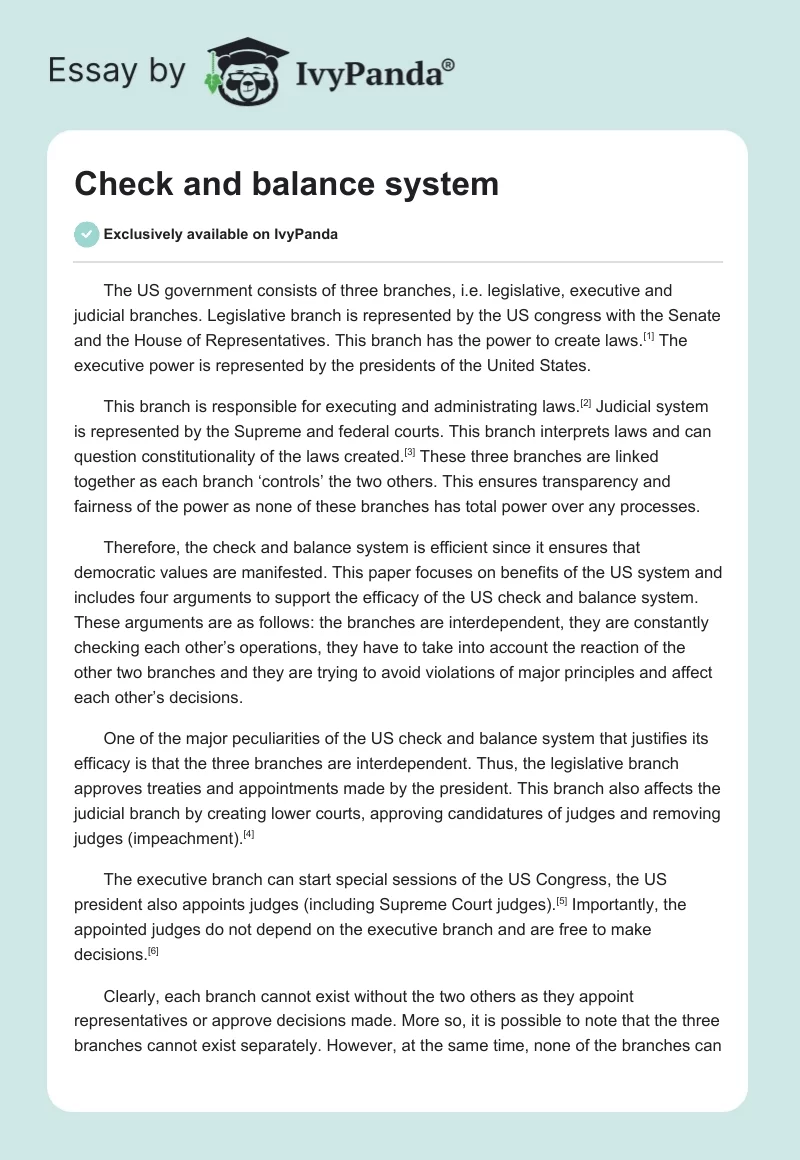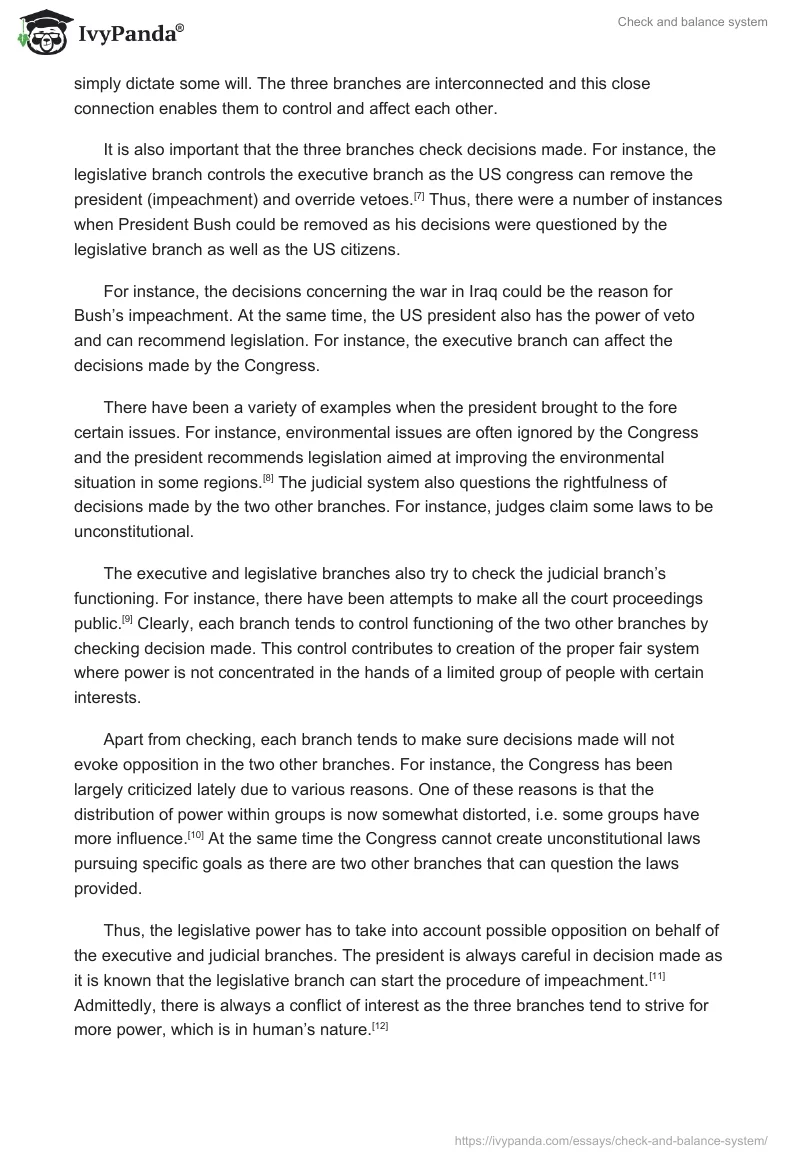The US government consists of three branches, i.e., legislative, executive and judicial branches. Legislative branch is represented by the US congress with the Senate and the House of Representatives. This branch has the power to create laws. The executive power is represented by the presidents of the United States.
This branch is responsible for executing and administrating laws. Judicial system is represented by the Supreme and federal courts. This branch interprets laws and can question constitutionality of the laws created. These three branches are linked together as each branch ‘controls’ the two others. This ensures transparency and fairness of the power as none of these branches has total power over any processes.
Therefore, the check and balance system is efficient since it ensures that democratic values are manifested. This paper focuses on benefits of the US system and includes four arguments to support the efficacy of the US check and balance system. These arguments are as follows: the branches are interdependent, they are constantly checking each other’s operations, they have to take into account the reaction of the other two branches and they are trying to avoid violations of major principles and affect each other’s decisions.
One of the major peculiarities of the US check and balance system that justifies its efficacy is that the three branches are interdependent. Thus, the legislative branch approves treaties and appointments made by the president. This branch also affects the judicial branch by creating lower courts, approving candidatures of judges and removing judges (impeachment).
The executive branch can start special sessions of the US Congress, the US president also appoints judges (including Supreme Court judges). Importantly, the appointed judges do not depend on the executive branch and are free to make decisions.
Clearly, each branch cannot exist without the two others as they appoint representatives or approve decisions made. More so, it is possible to note that the three branches cannot exist separately. However, at the same time, none of the branches can simply dictate some will. The three branches are interconnected and this close connection enables them to control and affect each other.
It is also important that the three branches check decisions made. For instance, the legislative branch controls the executive branch as the US congress can remove the president (impeachment) and override vetoes. Thus, there were a number of instances when President Bush could be removed as his decisions were questioned by the legislative branch as well as the US citizens.
For instance, the decisions concerning the war in Iraq could be the reason for Bush’s impeachment. At the same time, the US president also has the power of veto and can recommend legislation. For instance, the executive branch can affect the decisions made by the Congress.
There have been a variety of examples when the president brought to the fore certain issues. For instance, environmental issues are often ignored by the Congress and the president recommends legislation aimed at improving the environmental situation in some regions. The judicial system also questions the rightfulness of decisions made by the two other branches. For instance, judges claim some laws to be unconstitutional.
The executive and legislative branches also try to check the judicial branch’s functioning. For instance, there have been attempts to make all the court proceedings public. Clearly, each branch tends to control functioning of the two other branches by checking decision made. This control contributes to creation of the proper fair system where power is not concentrated in the hands of a limited group of people with certain interests.
Apart from checking, each branch tends to make sure decisions made will not evoke opposition in the two other branches. For instance, the Congress has been largely criticized lately due to various reasons. One of these reasons is that the distribution of power within groups is now somewhat distorted, i.e. some groups have more influence. At the same time the Congress cannot create unconstitutional laws pursuing specific goals as there are two other branches that can question the laws provided.
Thus, the legislative power has to take into account possible opposition on behalf of the executive and judicial branches. The president is always careful in decision made as it is known that the legislative branch can start the procedure of impeachment. Admittedly, there is always a conflict of interest as the three branches tend to strive for more power, which is in human’s nature.
However, the necessity to take into account the standpoint of the other branches makes each of them thoughtful. The system is based on the belief (which is quite correct) that even though two branches can agree to violate some principles, the third one will never become a part of such unlawful actions. The correctness of this assumption has been proved as the system still works.
Finally, apart from checking each other’s functioning and taking into account possible reactions, the three branches can influence one another. One of the most famous examples of the direct influence is Nixon’s veto in 1973. The military operations and the very peace in Iraq were at stake. The Congress and the president were in opposition and these two branches affected each other’s decisions. The power of the president was significantly restricted by the Congress.
Notably, when one of the branches acquires too much power the other two tend to take certain action. At present, the Congress is seen as something corrupted. Judicial system (and, in part, executive branch) is seen as one of the most powerful branches to restrict the power of the legislative branch and diminish corruption. Admittedly, the laws created can be easily questioned by the branch that has the responsibility to check constitutionality of each law. Clearly, the influence each branch has ensures proper functioning of the system.
In conclusion, it is necessary to note that the check and balance system is efficient. Firstly, the branches are interdependent and interconnected which makes them close enough to control each other. Secondly, the branches are constantly checking each other’s functioning which makes them aware of the processes that are taking place.
Thirdly, each branch is aware of the power of the other branches and has to take into account possibility of certain opposition. This makes the three branches more thoughtful and responsible. Finally, each branch can affect the decision made by the two others. This direct intervention enables the branches to control each other.
Therefore, the three closely connected but still separate bodies interact and create the system which has worked properly for decades. The US government has had certain constraints. There have been scandals and hard times. Nonetheless, Americans have been sure that the system works and the power is distribute properly between groups who are forced (as they are controlled by other groups) to work for the good of all.
Bibliography
Ackerman, Bruce, and Oona Hathaway. “Limited War and the Constitution: Iraq and the Crisis of Presidential Legality.” Michigan Law Review 109, no. 4 (January 2011): 447-517.
Calabresi, Steven G., Mark E. Berghausen, and Skylar Albertson. “The Rise and Fall of the Separation of Powers.” Northwestern University Law Review 106, no. 2 (2012): 527-549.
Corbett, Ross J. “Suspension of Law during Crisis.” Political Science Quarterly 127, no. 4 (2013 2012): 627-657.
Ewing, Benjamin, and Douglas A. Kysar. “Prods and Pleas: Limited Government in an Era of Unlimited Harm.” Yale Law Journal 121, no. 2 (2011): 350-424.
Gubanski, Jakub. “Comparative Criminal Justice.” Crime, Law & Social Change 41, no. 1 (2004): 15-32.
Mann, Thomas, and Norman Ornstein. “Yes, Congress Is That Bad.” Foreign Policy no. 197 (December 2012): 82-83.
Milligan, Susan. “Taking On Checks and Balances.” U.S. News Digital Weekly 4, no. 16 (April 20, 2012): 5.
Pandich, Scott C. “Six out of Seven: The Missing Sin of Federalist 51.” Perspectives on Political Science 36, no. 3 (2007): 148-152.
Peress, Michael. “Optimal Supermajority Requirements in a Two-Party System.” Journal of Politics 71, no. 4 (October 2009): 1379-1393.
Rothschild, Matthew. “Grounds for Impeachment.” Progressive 70, no. 4 (2006): 8-10.
Snider, J.H. “Solving a Classic Dilemma of Democratic Politics: Who Will Guard the Guardians.” National Civic Review 94, no. 4 (2005): 22-30.
Waxman, Henry. “Good Government.” Nation 282, no. 5 (February 6, 2006): 24-25.


